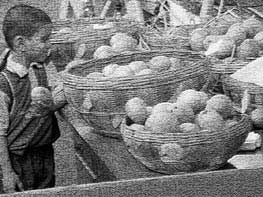I like to eat my mangoes the way monkeys eat them. Raw and whole, peel and bite in the ambrosia mass. It is rustic and like many rustic ways, brings out the truest taste of the fruit. But when a hostess in the numerous houses of obscure relatives I visit when I go to India asks me softly: “Diced?” I do not deny her the pleasure.
It is fashion-able to serve diced mangoes since only the finest mangoes can be diced. The ordinary ones in middle-class homes are sliced into four pulpy tongues and a seed lined with rind. There is a bewildering array of mangoes, heaped lustily on straw baskets of distant-eyed vendors. Each household has its own tradition surrounding the mango: I know of some families which every year buy their first mango, always the green fleshy langra in the second week of April and others which, like a part of nature itself, begin what will be an all-season negotiation with the roadside mango seller well into mid May. For they prefer the shriveled saccharine dussehri. A glistening golden slice of mango is part of family legend and ritual. If it was the United States, pop-psychology would have quickly asserted its quirky presence. Just like dog: needy, cat: independent, there might be a variation, langra : arrogant dussehri : low self-esteem. But Indian exporters- the rich untaxed class it is easiest to slip into and slide out of- seem to have in an air-conditioned conference collectively determined that the “Americans” like only the alphonso. Everyone I know in India refers to the alphonso jealously as “export quality.” I do too, jealously. Some are jealous because they cannot afford a fruit which is close to its worth in gold but most of us are so since we cannot understand why. Why do faraway rich palates gladly pay for a tiny version of their everyday mango which is not even versatile enough for pickle or milk shakes, and which sometimes tastes closer to papaya in its mildness should be exalted to “export quality” status and overpriced? It appears to be a minor outrage to our sensitivities, since we take our family mangoes personally. When I went to India last summer, I yearned to see nature’s culinary art hanging from mango-scented leaves. And when I drove down dusty country roads of Naini, close to Allahabad that summer – I smelt mangoes grow. I heard the taunting whistle of the koel and I knew I was in a mango orchard. I stopped the car – I think it was my childhood friend, the baby-elephant-like grey Ambassador – and climbed out to soak in the fragrance that was clinging to every particle of the yellow heat. There seemed to be no one but the trees seemed to nod in the hot loo breeze, like giant men in deep discussion. I felt a sense of unease mixed with dejavu. Then the koel hooted its rhapsody and I remembered those summer holidays with my cousins when we would lie on out backs in the burning grass, gaze at the faces in the mango trees and the white clouds above. |
Mango Memories

